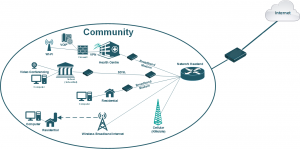In a 2010 paper, the director of economic development at the Assembly of First Nations outlined the e-Community strategy (Whiteduck, 2010). In her paper, Judy Whiteduck points out that Canada needs to maintain a skilled work force, and notes that First Nations can help fill that gap, particularly in the field of ICTs. She also points out that First Nation governments require a skilled public service, comparable to those in federal and provincial agencies. Employees need access to training and up-to-date equipment, and a means to manage their data resources. You can read Judy’s article here. A visual representation of the e-Community from K-Net services is presented below:
e-Community image from K-Net Services

The e-Community Strategy (AFN page, 2015) is the result of years of work. The initiative began in 2002, when the Chiefs-in-Assembly at the AFN directed their representatives to advocate government for funding to support broadband operations and management. In 2005, KO-KNET introduced the e-Community concept as a means to frame this work. At that time the organization was completing a SMART Communities Demonstration project with Industry Canada. That project – the only Indigenous-led SMART Communities project in Canada – focused on developing public-service oriented online applications, including e-learning, e-health, and e-governance. When the Prime Minister of Canada visited the region that spring, representatives from KO-KNET presented him with a briefing package introducing this e-Community work. They proposed to create, operate and manage a suite of e-applications for remote and rural First Nations.
The following year the AFN’s Chiefs Committee on Economic Development, which involved ICT experts from across Canada, held a workshop to discuss next steps. Participants noted that Chiefs-in-Assembly resolutions dating from 1997 to 2006 identified gaps in service support, funding, coordination, data management, and infrastructure. To help address these issues, the participants began to define a national broadband framework modeled on the e-Community strategy.
In 2008, the group presented this framework to the Chiefs-in-Assembly as the national e-Community strategy. The Chiefs endorsed the plan in AFN Resolution 16-2008. With financial support from the federal government, the AFN held a second meeting of the ICT Working Group. They identified several areas to include in the national framework, including infrastructure, sustainability, operations, management, and other issues of importance. During follow-up meetings, the ICT working group developed the concept, stressing the need to foreground a community-based development process. The group used the First Nations SchoolNet program as a model for the proposed e-Community initiative, expanding it to areas of health, economics, governance, justice, and other community services.
The e-Community strategy was re-affirmed in AFN Resolution 2011-09/53-2011. That resolution noted that national research partnerships can monitor, evaluate, and explore the effective use of ICTs in First Nations communities. The resolution also noted that the e-Community strategy is compatible with a First Mile approach, stressing the opportunity for First Nations to own, control and manage their local broadband infrastructure, and the services and data flowing through their local networks. Policies to support a First Mile approach include supporting community members to use these technologies effectively, and ensuring they have the capacities to do so.
According to the AFN’s 2018 Annual Report the e-community strategy “remains an unfunded activity at the AFN and this has limited the activity in the portfolio as it relates to national discussions and strategic initiatives”. The 2019 Annual Report has only a brief reference to the 2008 resolution. While the e-community strategy may no longer be a prominent part of the AFN’s policy initiatives, it was an important part of the movement to coordinate and mobilize a digital infrastructure strategy for First Nations in Canada and that work continues and includes initiatives by individual First Nations, Federal and Provincial Governments and other organizations, including the First Mile Connectivity Consortium.
This work continues today, including by the First Nations Technology Council in B.C., which is currently developing an Indigenous Digital Equity Strategy (IDES) in consultation with First Nations across the province. As noted on FNTC’s website:
“The First Nations Technology Council defines digital equity as a state in which every Indigenous person, community and Nation is fully equipped to access and effectively use technology to contribute, thrive, and succeed in today’s digital society while preserving self-determination.
We know digital equity is more than just access to computers and the internet, it is about influence over the trajectory of technology and its impacts on society. Digital equity is a prerequisite for innovation, self-governance, entrepreneurship, education, economic and cultural wellbeing, and nearly all aspects of rights implementation in the digital age.”
In the coming months, FNTC will be engaged in co-creating an Indigenous Digital Equity Strategy that reflects many of the goals and approaches expressed in the e-Community strategy and beyond.
